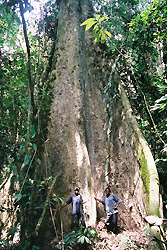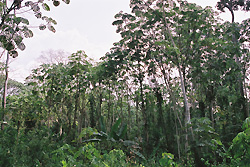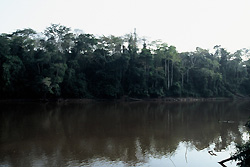(3) The field research was conducted from 15 January to 31 March 2005 in Mindourou village and areas along the Dja River in the Boumba-Ngoko District of East Province, Cameroon. It focused particularly on historical changes in forest use and the impacts of these changes on the dynamics of forest vegetation. The research was comprised of: (1) interviews about the historical background (especially the migratory history of the villages), and (2) a vegetation survey of an old village site.
My preceding research revealed that the people in the study area had moved their villages from an area about 30 km upstream along the Dja. In the present study, twenty old village sites were located by GPS (see previous report) along the migration route. It has generally been assumed that shifting cultivators move their settlement sites, when facing a shortage of adequate land, in order to clear new fields in the nearby forest. In my research area, however, their movements were mainly done for other reasons, such as conflicts with other ethnic or kin groups, the death of leaders, the spread of infectious diseases, increases in the number of tombs, and other “social” reasons. From the 1930s to 1960s, the former colonial or independent Cameroon government forced the people to move their villages downstream along the Dja. In the 1970s, a logging company constructed a road, and the people moved their settlement sites to the roadside to have easier access to the town, hospital and other modern facilities. These socio-political factors and the changes in the social conditions had a great influence on their lifestyle. At the same time, when people build a new village, they usually
choose an area where they can find good drinking water or good forest for clearing fields. These social as well as ecological factors influence the life of the forest people and their relationships with the forest, which in turn influence the forest vegetation.
I conducted a vegetation survey of an old village that had been abandoned for more than 40 years. Some plants, such as cacao, grapefruits and oil palms, which had been planted by the villagers when they were occupying the area, could still be found. The vegetation survey showed that the same shade-intolerant type species were found in the canopy layers as those comprising the mature forest of the region. Of them, Albizia adianthifolia (Mimosoideae) and Terminalia superba (Combretaceae) accounted for a large percentage by basal area. In the canopy layers of younger secondary forest aged 10 to 20 years, Musanga cecropioides (Cecropiaceae) was the dominant species, with its dominance decreasing as the forest grew older. In the old secondary forest aged more than 20 years, such as the old village site surveyed in this study, Musanga trees had died and disappeared from the vegetation, and the composition of the tree species varied from place to place. This difference may have been a result either of differences in the original composition of the forest species, or from the trees left in the fields when the people cleared the forest. In the latter case, it would mean that the people had left an impact on the vegetation even after abandoning the fields.
Previous studies by Atanga (1998) and Chujo (1992) reported that semi-deciduous forests in eastern Cameroon are characterized by a high frequency of shade-intolerant species in the canopy layers and a low potential of natural regeneration. Chujo (1992) suggested that large gaps left by human activities (i.e., slash and burn agriculture) may have promoted the regeneration of the semi-deciduous forests in the region. My research also showed that many kinds of shade-intolerant species are found in the canopy layers of the so-called "primary forest," whereas immature trees of the same species are seldom found in the lower layers. This suggests that the forest environment we see today may have been largely modified through human activities, such as agriculture or habitation. The forests in my study area were probably heavily influenced by the shifting cultivation with long fallow periods, which allowed the vegetation to grow for more than 20 years. Today, people have settled along the roads, and for fields they re-use the young secondary forests dominated by Musanga trees at intervals of 10 to 15 years. This method of forest use is sustainable in the short term. From a longer perspective, however, the regenerated forest lacks the diversity of tree species that characterized the former vegetation, since some shade-intolerant species do not grow and regenerate themselves if the old secondary forests do not continue to grow after the death of the Musanga trees.
I plan to carry out further research on the vegetations of the "primary" forest and several old village sites along the Dja. Information about the ecological history of the area will also be collected in order to gain an understanding of the historical relationships between human
activities and forest environments. Through these investigations, I would like to reconstruct the ecological history of the forests, and to attempt to assess the present condition and sustainability of forest use in the study area.
- Atanga, E. 1998. Large Mammals and Vegetation Surveys in the Boumba-Bek and Nki Project Area, Research Report WWF CAMEROON PROGRAMME.
- Chujo, H. 1992. Ecology of the tropical semi-deciduous forest and the possibility of its sustainable use in east Cameroon, West Africa. Journal of African Studies 41: 23-45 (in Japanese).



 21st Century COE Program
-Aiming for COE of Integrated Area Studies-
21st Century COE Program
-Aiming for COE of Integrated Area Studies-